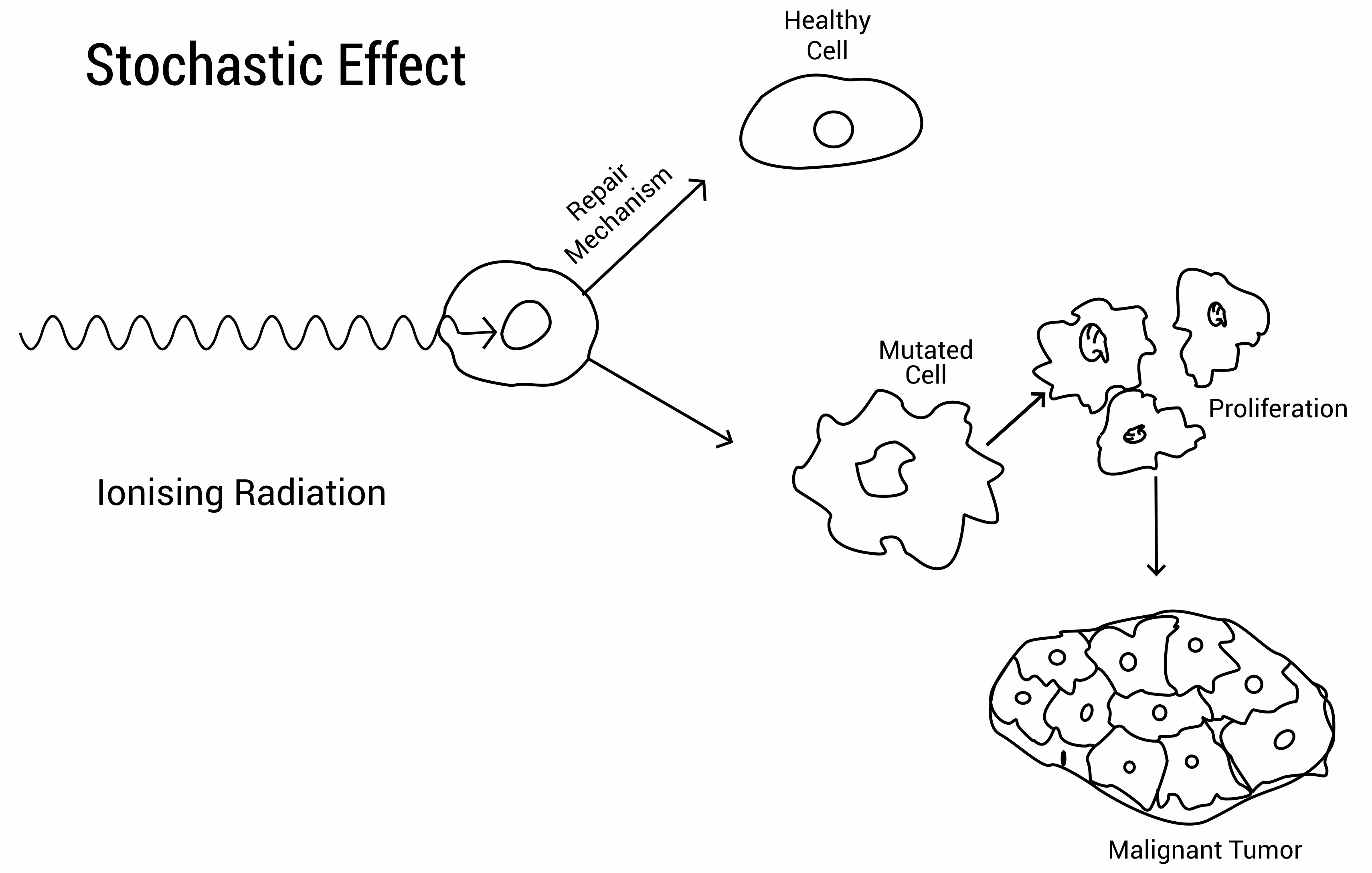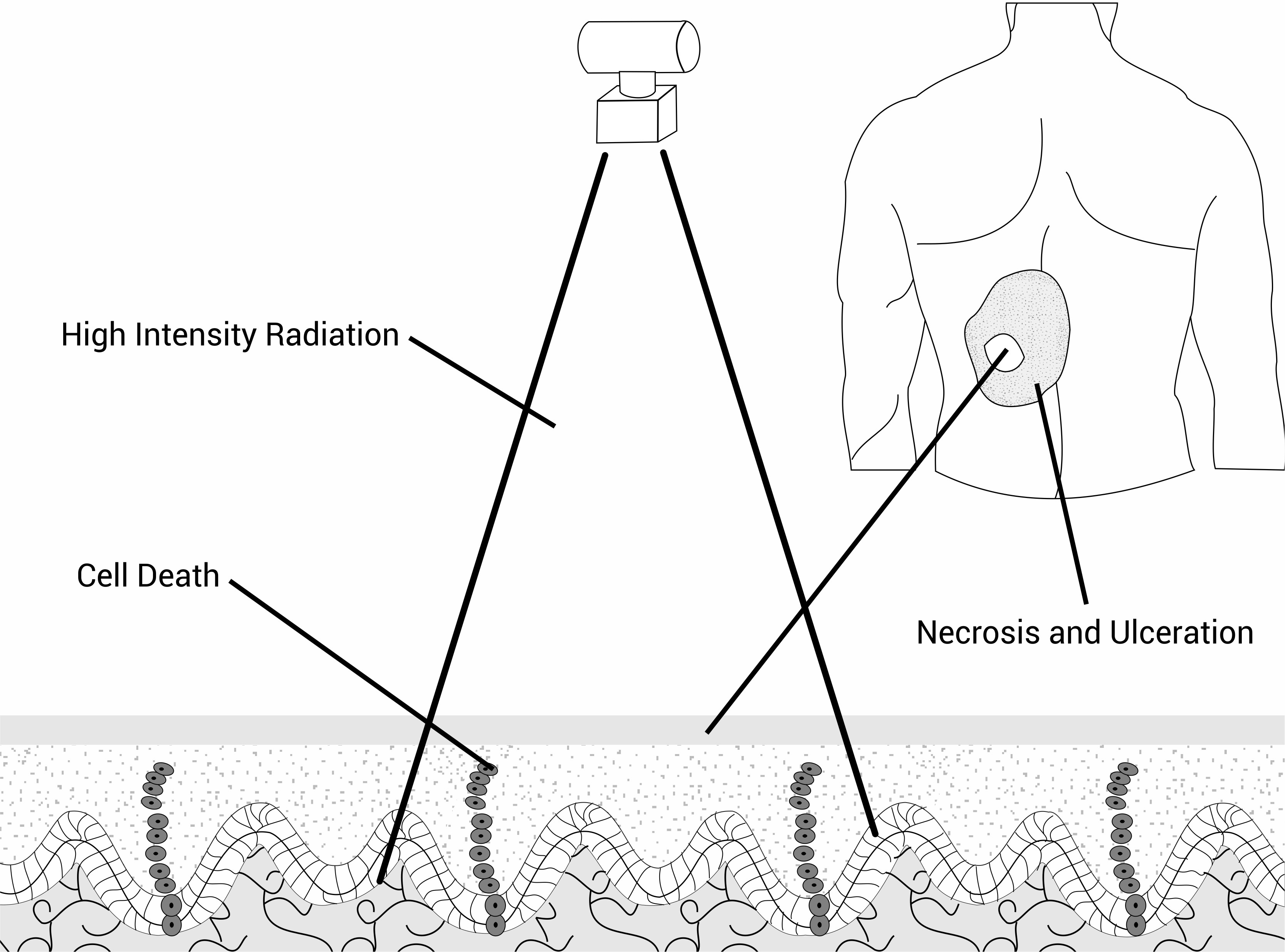Discuss what is meant by Deterministic Effects and Stochastic Effects.
The theory
High doses of ionising radiation have adverse health effects on the exposed individuals. The effects are categorised into two groups: stochastic effects and deterministic effects.
Stochastic Effect
Stochastic effects are random occurrences and show up as cell mutations rather than cell death. The most accepted theory, and is the basis of most regulations, is they are applicable at all dose levels, i.e. there is no threshold dose were below the chance of the effect occurring is zero (Linear No Threshold Model). There is debate whether this model is the most appropriate, particularly at low-dose levels such as those in most radiological procedures, however as it is the most widely accepted theory the remainder of this exam revision post will assume the Linear No Threshold Model.
In most cases, any cell mutations caused by ionising radiation will be eliminated by the body’s defence, however in rare occasions that this does not occur the mutations can induce cancers. The severity of the effect is unrelated to the amount of dose given, i.e. the result of cancer is the same whether it followed from 1 Gy or 100 Gy exposure. However, the probability of the effect occurring increases with increased radiation dose. This is due to the likelihood of the cancer effect occurring relating to the number of modified cells created by the initial exposure. In other words, the more mutated cells created, the greater the chance of one of those cells by passing the body’s natural defence system and inducing cancers. It can be difficult to associate cancer with a radiation incident since radiation induced cancers are indistinguishable from any other cancer. To estimate stochastic effects we can use 5% per Sv for adults and 15% per Sv for children.

Figure 1 – Radiation induced carcinogenesis occurs following interaction with ionising radiation that leads to cell mutation. If the cell is left to proliferate then radiation induced cancers can occur.
Deterministic Effect
On the other hand, deterministic effects occur when there is enough cell death within an organ which leads to a functional loss of the irradiated organ. For these effects, a threshold radiation dose does exist. Below this threshold dose, the organ is not compromised by the death of a limited number of cells. Beyond the threshold dose, the pathological severity of the effect will vary based on the proportional amount of cell deaths within the organ. These effects could range from temporary reactions to organ death. The severity of the effect increases with increased radiation dose. An example of a deterministic effect in Radiology is skin burns following prolonged fluoroscopically guided interventions. An example of deterministic effect related to the staff is radiation-induced posterior lens opacities.

Figure 2 – A radiation source delivering a high dose to one location on the patient’s skin can lead to significant cell death which can manifest as erythema, ulceration or skin necrosis.
The question
Discuss what is meant by Deterministic Effects and Stochastic Effects
In this question it is important to address three things:
- Define the terms in the question.
- Discuss the relationship between radiation dose.
- Give examples of the effect.
In the first part of this question, the student should define both deterministic effects and stochastic effects. Following that the student should comment on if there is a dose threshold and how the severity of the effect relates to radiation dose. Finally, the student should finish the response by giving examples of the two effects.
The sentence structure should be, “Deterministic effects are ____. There is a threshold below which the effect can not occur. The severity of the effect ____ with increased radiation exposure. An example of a deterministic effect is ____. Stochastic effects are ____. There is no threshold dose below which the probability of incidence is zero. The severity of the effect ____ with increased radiation exposure. An example of stochastic effects are____.”
Sample answer
Discuss what is meant by Deterministic Effects and Stochastic Effects (4 marks)
Deterministic effects are effects that occur following a significant number of cell deaths within an organ. There is a threshold below which the effect can not happen. The severity of the effect increases with increased radiation exposure. An example of a deterministic effect is transient erythema of the skin following exposures to a skin site greater than 2 Gy. Stochastic effects are probabilistic and due to cell mutations not being repaired and inducing cancerous cells. There is no threshold dose below which the probability of incidence is zero. The severity of the effect is unchanged with increased radiation exposure. An example of stochastic effects is leukaemia.”
Did you find this useful or would you answer this question any differently? Comment below.
Good one Mo